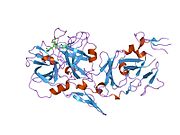Factor VII
The article's lead section may need to be rewritten. The reason given is: More than half of the lead is about recent pharmaceuticals, not the natural protein. (April 2024) |
Ensembl | |||||||||
|---|---|---|---|---|---|---|---|---|---|
| UniProt | |||||||||
| RefSeq (mRNA) | |||||||||
| RefSeq (protein) | |||||||||
| Location (UCSC) | Chr 13: 113.11 – 113.12 Mb | Chr 8: 13.08 – 13.09 Mb | |||||||
| PubMed search | [3] | [4] | |||||||
| View/Edit Human | View/Edit Mouse |
Coagulation factor VII (EC 3.4.21.21, formerly known as proconvertin) is a protein involved in coagulation and, in humans, is encoded by gene F7. It is an enzyme of the serine protease class. Once bound to tissue factor released from damaged tissues, it is converted to factor VIIa (or blood-coagulation factor VIIa, activated blood coagulation factor VII), which in turn activates factor IX and factor X.
Using
In April 2020, the US FDA approved a new rFVIIa product, eptacog beta (SEVENFACT), the first bypassing agent (BPA) approved in more than 2 decades. As an rFVIIa product, eptacog beta works in a complex with tissue factor to activate factor X to Xa, thereby bypassing FVIII and FIX. The activation of Factor X to Xa initiates the coagulation cascade’s common pathway, leading to clot formation at the site of hemorrhage. Activated FVII binds to endothelial protein C receptor (EPCR), which enhances hemostasis.14 One study showed that eptacog beta binds to EPCR with 25% to 30% more affinity than eptacog alfa, displacing protein C from EPCR binding sites and downregulating activated protein C generation, contributing to its hemostatic effect.
Physiology
The main role of factor VII (FVII) is to initiate the process of coagulation in conjunction with tissue factor (TF/factor III). Tissue factor is found on the outside of blood vessels - normally not exposed to the bloodstream. Upon vessel injury, tissue factor is exposed to the blood and circulating factor VII. Once bound to TF, FVII is activated to FVIIa by different proteases, among which are thrombin (factor IIa), factor Xa, IXa, XIIa, and the FVIIa-TF complex itself. The complex of factor VIIa with TF catalyzes the conversion of factor IX and factor X into the active proteases, factor IXa and factor Xa, respectively.[6]
The action of the factor is impeded by tissue factor pathway inhibitor (TFPI), which is released almost immediately after initiation of coagulation. Factor VII, which was discovered around 1950, is vitamin K-dependent and produced in the liver. Use of warfarin or similar anticoagulants decreases hepatic synthesis of FVII.[citation needed]
A coagulation
Structure
Factor VII shares a common domain architecture with factors IX and X.
Genetics
The gene for factor VII is located on chromosome 13 (13q34).
Role in disease
Medical uses
It has also been used in the setting of uncontrollable hemorrhage,[9][10] but its role in this setting is controversial with insufficient evidence to support its use outside of clinical trials.[11] The first report of its use in hemorrhage was in an Israeli soldier with uncontrollable bleeding in 1999.[12] Risks of its use include an increase in arterial thrombosis.[11] However, animal studies have not shown complications as seen in humans, in fact same of the studies show a better prognosis. In the military settings it is used as an off label intervention in complications related to disseminated intravascular coagulation related haemorrhage caused by penetrating trauma.[13]
Recombinant human factor VII while initially looking promising in intracerebral hemorrhage failed to show benefit following further study and this is no longer recommended.[14][15]
Interactions
Factor VII has been shown to
References
- ^ a b c GRCh38: Ensembl release 89: ENSG00000057593 – Ensembl, May 2017
- ^ a b c GRCm38: Ensembl release 89: ENSMUSG00000031443 – Ensembl, May 2017
- ^ "Human PubMed Reference:". National Center for Biotechnology Information, U.S. National Library of Medicine.
- ^ "Mouse PubMed Reference:". National Center for Biotechnology Information, U.S. National Library of Medicine.
- S2CID 58538425.
- S2CID 205121835.
- PMID 23615029.
- PMID 26702064.
- PMID 15328151.
- ^ "Uncontrolled Bleeding and Injury Lawsuit Claims". Archived from the original on 2016-06-16. Retrieved 2015-08-26.
- ^ PMID 22419303.
- S2CID 23159895.
- S2CID 10776054.
- PMID 15728810.
- PMID 18480205.
- PMID 12787023.
- PMID 9925787.
Further reading
- Broze GJ, Majerus PW (February 1980). "Purification and properties of human coagulation factor VII". The Journal of Biological Chemistry. 255 (4): 1242–1247. PMID 7354023.
- Versteeg HH, Peppelenbosch MP, Spek CA (December 2001). "The pleiotropic effects of tissue factor: a possible role for factor VIIa-induced intracellular signalling?". Thrombosis and Haemostasis. 86 (6): 1353–1359. S2CID 10976556.
- Golino P (May 2002). "The inhibitors of the tissue factor:factor VII pathway". Thrombosis Research. 106 (3): V257 – V265. PMID 12356487.
External links
- Official website
- The MEROPS online database for peptidases and their inhibitors: S01.215 Archived 2020-05-29 at the Wayback Machine
- CHES - Comprehensive Health Education Services LLC - Factor VII treatment and awareness [1]

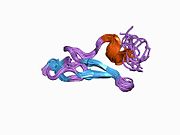



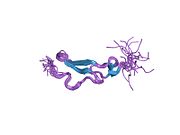



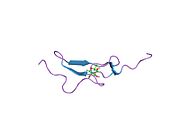
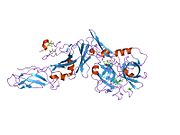















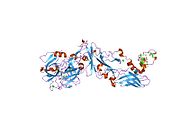

![2aei: Crystal structure of a ternary complex of factor VIIa/tissue factor and 2-[[6-[3-(aminoiminomethyl)phenoxy]-3,5-difluro-4-[(1-methyl-3-phenylpropyl)amino]-2-pyridinyl]oxy]-benzoic acid](http://upload.wikimedia.org/wikipedia/commons/thumb/d/d2/PDB_2aei_EBI.jpg/180px-PDB_2aei_EBI.jpg)

